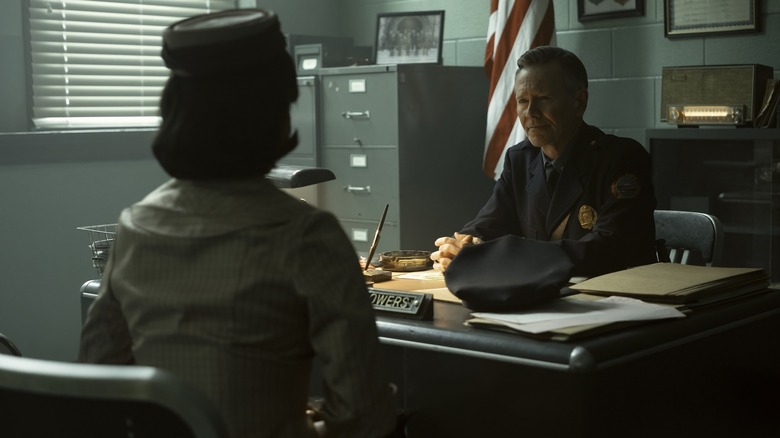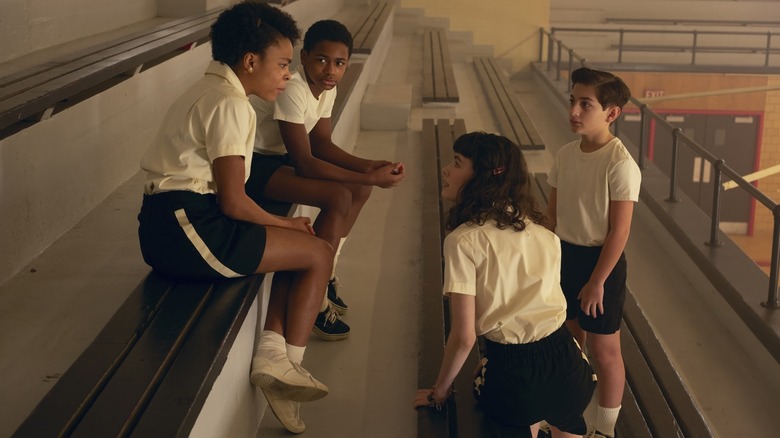The Best Part Of It: Welcome To Derry Has Nothing To Do With The Monsters
Warning: Spoilers float, too. The following article contains major spoilers for episode 4 of "It: Welcome to Derry."
"It: Welcome to Derry" is several things in one: a prequel to the pair of successful blockbuster movies, a companion piece expanding on Stephen King's "It" novel, and a fresh, original narrative pushing back against the confines of modern franchise IP-building trends. Such an ambitious project likely wasn't in the cards for even the biggest horror fans out there. After all, an "It" prequel series implicitly promising to tell the origin story of the killer clown from outer space (okay, yes, it's a little more complicated than that) certainly sounds like as uninspired a choice as it gets these days. Yet, the results so far, as /Film's Chris Evangelista wrote in his review of the show, are "smarter and scarier than expected."
Much of that has to do with how main creative developers Jason Fuchs, Andy Muschietti, and Barbara Muschietti have decided to unfold the series of events centered on the (fictional) cursed town of Derry, Maine. The early twist at the end of the premiere, which cruelly did away with what we thought would be the new batch of kids making up the series' version of the Loser's Club, helped inject a sense of shock and unpredictability into the main plot. But, as much as the gruesome and effective scares tend to hog the spotlight, we'd be remiss to call this the greatest strength of "Welcome to Derry." Episode 4, titled "The Great Swirling Apparatus of Our Planet's Function," is perhaps the best display yet of what the HBO show does so well ... and, no, it has nothing to do with all those monsters lurking around every corner.
It: Welcome to Derry uses the 1960s as an actual setting, not a backdrop
The dark, clown-shaped conspiracy at the heart of Derry is getting closer and closer to coming to light, but that's far from the biggest concern in the world of "It: Welcome to Derry." Much like the 1980s-set "It" movie, the series hasn't been shy about loading up every episode with nostalgic signposts and signifiers of its period era. You have kids hitchhiking with complete strangers in the show's opening scene (to be fair, this didn't exactly work out well for him), schools showing government-sponsored videos on how to survive atomic blasts (by hiding beneath their desks, natch), and the barely-disguised racism pervading every corner of society. (Okay, this last bit isn't all that different from today, admittedly.)
To give them their proper due, the writing team behind "Welcome to Derry" have gone out of their way to make every world-building detail of this setting feel alive and vital to the arc of the show — not merely as window-dressing or a backdrop to all the action going on. Frequent news broadcasts on television and radio in various scenes make it clear that the Cuban Missile Crisis is currently devolving fast elsewhere in the world. The collective dread over the impending threat of atomic annihilation practically seeps into every street and old-fashioned brick building of Derry. Of course, the rapidly-escalating Cold War proves to be the entire impetus behind the American military's interest in It in the first place, laughably convinced they can use this "entity" as a weapon to incite mass fear in their enemies.
And that's not even counting the most innocuous of the show's '60s imagery: our main group of kids simply trying to survive a day in school amidst all this mayhem.
It: Welcome to Derry's school subplot isn't as extraneous as it may feel
What's worse than having to fend off a cosmic horror hell-bent on feeding on your fear? How about trying to dodge bullies and avoid getting publicly humiliated without alienating your friends? It's almost a rule of television: Every hit new show must have that one subplot that doesn't hit as hard as the rest. For many viewers, that might end up taking the form of, well, all the scenes set at the kids' school in Derry. It would've been easy, some may criticize, to simply set this show during the school-free summer months and avoid the boring confines of an unremarkable school to begin with — something the first "It" movie did to great success in 2017.
Instead, it just so happens there's a pretty solid reason why "Welcome to Derry" makes this particular choice. Even if certain viewers haven't felt entirely gripped by the drama surrounding Lilly Bainbridge (Clara Stack) and frenemy Marge Truman (Matilda Lawler), episode 4 reveals where all this has been building up to. An early class lesson about parasitic worms taking over snails comes back to haunt this pair in the worst way imaginable. Rather than simply terrorize the kids with monsters that merely threaten to attack, It manifests as a parasite that bloats Marge's eyes and makes her try to literally rip them out — a grotesque and gory series of events that leads to Lilly getting set up to look like she stabbed her former friend in the eyes. In one fell swoop, all these school scenes suddenly become integral to Lilly's arc and her efforts to avoid the asylum. Bleak, bleak stuff.
New episodes of "It: Welcome to Derry" stream on HBO and HBO Max every Sunday.


